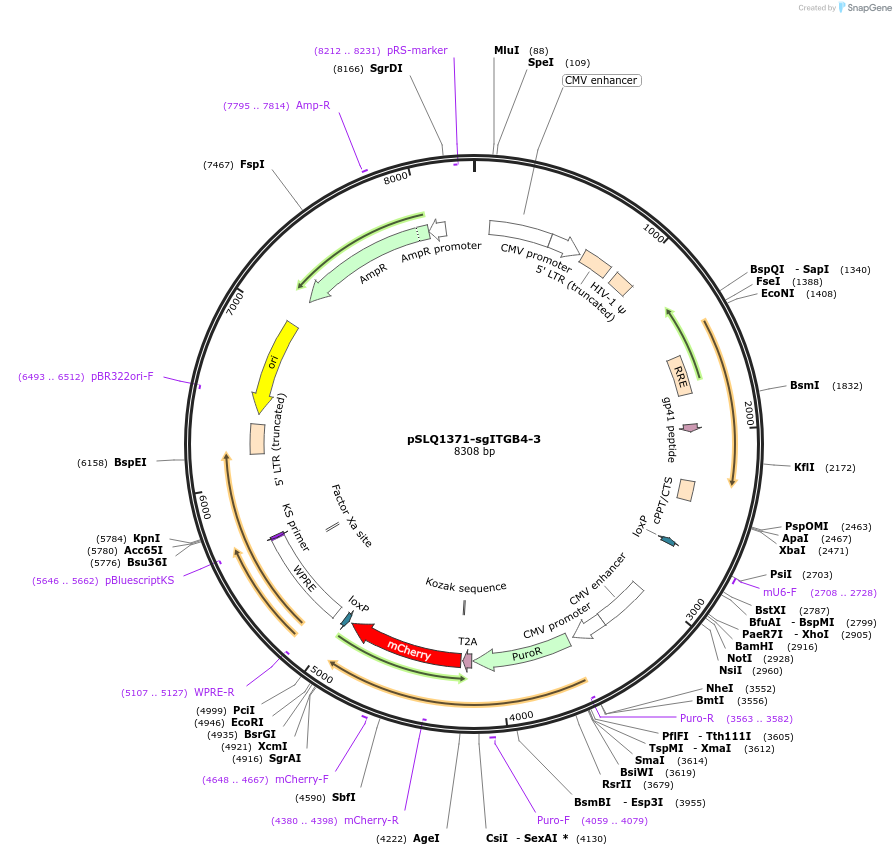pSLQ1371-sgITGB4-3
(Plasmid
#121536)
-
PurposesgITGB4-3 sequence: GAGGAGCGTAGGTCCTCGCAG. Lentiviral mouse U6 (mU6) promoter-driven expression vector that coexpessed Puro-T2A-mCherry from a CMV promoter.
-
Depositing Labs
-
Sequence Information
Ordering
| Item | Catalog # | Description | Quantity | Price (USD) | |
|---|---|---|---|---|---|
| Plasmid | 121536 | Standard format: Plasmid sent in bacteria as agar stab | 1 | $89 | |
Backbone
-
Vector backbonepSLQ1371
- Total vector size (bp) 8319
-
Vector typeMammalian Expression, Lentiviral, CRISPR
-
Selectable markersPuromycin
Growth in Bacteria
-
Bacterial Resistance(s)Ampicillin, 100 μg/mL
-
Growth Temperature37°C
-
Growth Strain(s)NEB Stable
-
Copy numberUnknown
Gene/Insert
-
Gene/Insert namesgITGB4-3
-
SpeciesH. sapiens (human)
-
Insert Size (bp)21
- Promoter mouse U6
-
Tag
/ Fusion Protein
- mCherry (C terminal on backbone)
Cloning Information
- Cloning method Restriction Enzyme
- 5′ cloning site BstXI (not destroyed)
- 3′ cloning site XhoI (not destroyed)
- 5′ sequencing primer GAGATCCAGTTTGGTTAGTACCGGG
- (Common Sequencing Primers)
Resource Information
-
A portion of this plasmid was derived from a plasmid made byAntonia A. Dominguez and Lei S. Qi, Stanford University
Terms and Licenses
-
Academic/Nonprofit Terms
-
Industry Terms
- Not Available to Industry
Trademarks:
- Zeocin® is an InvivoGen trademark.
These plasmids were created by your colleagues. Please acknowledge the Principal Investigator, cite the article in which the plasmids were described, and include Addgene in the Materials and Methods of your future publications.
-
For your Materials & Methods section:
pSLQ1371-sgITGB4-3 was a gift from Ovijit Chaudhuri & Stanley Qi (Addgene plasmid # 121536 ; http://n2t.net/addgene:121536 ; RRID:Addgene_121536) -
For your References section:
Identification of cell context-dependent YAP-associated proteins reveals beta1 and beta4 integrin mediate YAP translocation independently of cell spreading. Lee JY, Dominguez AA, Nam S, Stowers RS, Qi LS, Chaudhuri O. Sci Rep. 2019 Nov 20;9(1):17188. doi: 10.1038/s41598-019-53659-4. 10.1038/s41598-019-53659-4 PubMed 31748579








